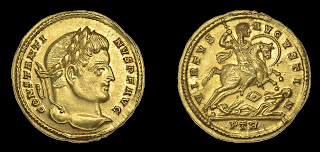The Unified Kingdom of Georgia in the Middle Ages stretched from the Black Sea to the Caspian Sea. When it was conquered by the Byzantine Empire, the daughter of its then ruler, Bagrat IV, was taken to Constantinople as a hostage in 1056. She was five years old. Martha of Alania, called Maria in Constantinople, was raised and educated by the Empress Theodora; when Theodora died a year later, Maria was sent home.
In 1065, to further unite Georgia and the empire, Maria was married to Michael VII Doukas, who was in line to become emperor in 1071. Unfortunately for Michael, his reign experienced military disasters and economic woes, and in 1078 a coup replaced him with Nikephoros III Botaneiates. Michael was forced into a monastery and became a monk, and Maria with her young son Constantine was sent to a monastery (but did not become a nun).
Nikephoros was widowed while in office, and his intention to remarry started a fierce competition among all the eligible noblewomen. He settled on Maria for several reasons: marrying her would assuage the hostility of her Doukas relatives after the ouster of her first husband; her foreign birth meant she had no blood relatives who would try to use her empress status as a way to garner power for themselves, and she was a known beauty:
And certainly she was as slender of stature as a cypress, her skin was white as snow, and though her face was not a perfect round, yet her complexion was exactly like a spring flower or a rose. And what mortal could describe the radiance of her eyes? Her eyebrows were well-marked and red-gold, while her eyes were blue. Full many a painter's hand has successfully imitated the colours of the various flowers the seasons bring, but this queen's beauty, the radiance of her grace and the charm and sweetness of her manners surpassed all description and all art. Never did Apelles or Pheidias or any of the sculptors produce a statue so beautiful. [from the Alexiad]
She was still married to Michael, however, and the Orthodox Church considered a marriage to Nikephoros to be adulterous. The first priest who was asked to perform the marriage refused (and was demoted), but the next one was willing to accommodate the couple. Nikephoros agreed as part of the marriage pact to make her son from her first husband the heir to the empire, but he later went back on his word.
She allied with Anna Dalassene, and adopted her son Alexios in order to give him closer ties to the palace and the emperor; this allowed Anna and Alexios and Maria to plan to replace Nikephoros. Maria would have liked her son to become emperor, but he was still a child, and when the coup took place in 1081, Alexios became emperor. Alexios made Constantine his heir, even betrothing his own daughter Anna Comnena to the boy. Maria was treated well and remained in imperial quarters at Mangana, a suburb of Constantinople. As mother of the imperial heir, she lived a lavish lifestyle, making donations to a monastery and building a convent at Jerusalem. She was a patron to literary figures.
When Alexios and his wife bore a son of their own, however, the betrothal between Anna Comnena and Constantine was called off, Constantine was declared no longer heir, and Maria was retired to a monastery. Constantine died in 1096. Maria died in 1118, remaining an important figure to her fellow Georgians.
About the Alexiad that wrote so glowingly about Maria: it was written by Anna Comnena, Alexios' daughter, and we're going to look at her next time.










